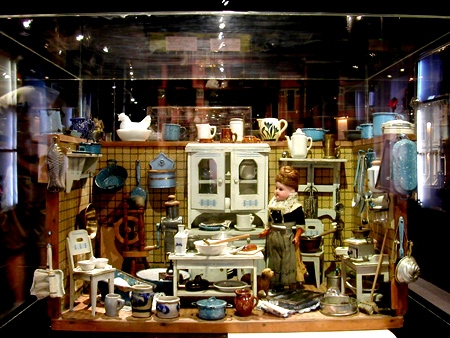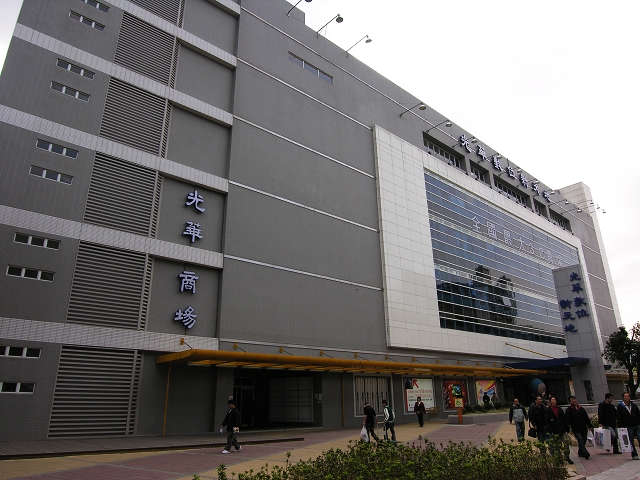
The Miniatures Museum of Taiwan (Chinese: 袖珍博物館; pinyin: Xiùzhēn Bówùguǎn)is the first museum to collect miniatures in Asia. The museum was founded on March 28, 1997 by Mr Lin Wen-ren and his wife. It is located in Taipei City, Taiwan. Mr. Lin and his wife enjoyed buying little houses and toy cars for their children while traveling for business purposes. While in Netherlands, they discovered miniature art and were deeply attracted. They began buying accessories, furniture, and assembled miniature houses. At the same time, the couple participated in auctions and joined international miniature art associations. They began planning their museum in 1993. The logo of the museum comes from "Rose Mansion", one of the museums most famed collections. Chosen as one of ten most significant miniature art works of America in twenty-five years, "Rose Mansion" consumed Dr. Reginald Twigg almost four years to complete.[3] After his elaborate research and study the once famous architecture has been brought back to life as you now see in the museum. The logo represents delicate, real, dream-like, romantic, and historically correct nature of miniature arts.

Guang Hua Market was established by the Taipei City Government in 1973 as a retailer market, using the space beneath the old Guanghua Bridge. Originally, the market specialized in old books, giving it the nickname "old books street". Within a decade, however, electronics retailers gained presence in the market. Due to underground railroad construction in 1992, Guang Hua Market was moved to an underground location at the corner of Bade Road and Xinsheng South Road. By this time, the area became known for electronics, with many new stores opening, and the establishment of other electronic markets such as the International Electronics Market, Contemporary Life Market, and Sanpu Market. In 2006 due to the deconstruction of the Guanghua Bridge, Guang Hua market was moved to a temporary location at the corner of Jinshan North Road and Civic Boulevard. The temporary building consisted of five warehouse-like halls, providing a total of 196 retail stores. Not soon after market moved into its temporary location, construction began on the current six-story Guang Hua digital plaza building. This has been the current location since July 2008. The Guang Hua Digital Plaza building today consists of six stories above ground and one story below ground. The first story above ground is an exhibition space for electronic products. The second and third stories are the new locations for the 196 vendors of the original Guang Hua Market. The fourth and fifth stories are the new locations for the vendors of Xining Guozhai Electronics Market. The sixth floor is reserved for repair shops, education classes, and offices. The basement floor is parking.
In 2007 the Taiwan Cultural-Creative Development Co. Ltd assumed responsibility for the renovation and operation of the Park and renamed it Huashan 1914. An organically creative environment has been growing ever since. Huashan 1914 now serves as Taipei’s primary creative arts center and a hosting ground for Taiwan’s most significant cultural activities. Examples include the Simple Life music festival and the BiBo student design expo. Today Huashan 1914 is not only the heart of Taiwan’s creative pulse, but also a bridge to a unique architectural past.
The former American Consulate in Taipei in Taiwan is located in the Zhongshan District of Taipei City. The Consulate building began operations in 1925 and in 1926 a two story western style building was erected. The building is close to the overall style of the US South and Victorian. The building has a total area of 375 square feet (34.8 m2).
Converted from the 2010 Taipei International Flora Expo, the TAIPEI EXPO PARK is an urban recreational facility that comprises three typical park areas (Yuanshan, Taipei Fine Arts Museum and Xinsheng) while offering venues for the hosting of various events in the former Flora Expo’s pavilions. Among the iconic Flora Expo displays, still available, on the parks’ premises, mostly featuring perennial flowering/foliage plants and turfs, are the 3-dimensional Green Walls, Flower Walls, “Flora Rainbows", Special Exhibition Area, Flower Landscape, Rare Flowers & Plants Area, and Fruit Tree Area, which aim to keep the Expo’s images and variety alive, while impressing park visitors with the openness of a vision of verdure, combined with enhanced recreational quality. The TAIPEI EXPO PARK is also perfect for accommodating the hosting of exhibitions or other events as it lies strategically in the vicinity of MRT Yuanshan Station.
The Taipei Metro Zhongshan Station (Chinese: 中山站; pinyin: Zhōngshān Zhàn) is a station on the Tamsui Line, located on the border of Zhongshan and Datong districts, Taipei, Taiwan.It is a planned transfer station between the Tamsui Line and Songshan Line. The station opened on March 28, 1997 for traffic on the Tamsui Line, and Songshan Line services opened on November 15, 2014. It is located in the middle of the underground Zhongshan Metro Mall. Exit 4 was recently reconstructed with transparent, self-cleaning glass to better integrate with nearby department stores.The new Songshan Line station will have a theme of "Happy Transit".